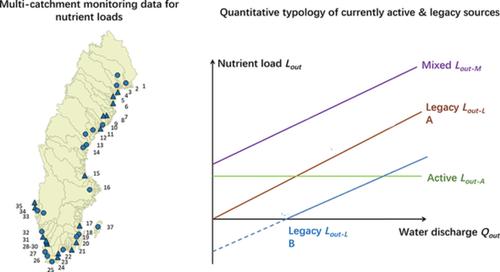当前位置:
X-MOL 学术
›
Hydrol. Process.
›
论文详情
Our official English website, www.x-mol.net, welcomes your feedback! (Note: you will need to create a separate account there.)
Nutrient source attribution: Quantitative typology distinction of active and legacy source contributions to waterborne loads
Hydrological Processes ( IF 3.2 ) Pub Date : 2021-06-24 , DOI: 10.1002/hyp.14284 Yuanying Chen 1, 2 , Georgia Destouni 1 , Romain Goldenberg 1 , Carmen Prieto 1
Hydrological Processes ( IF 3.2 ) Pub Date : 2021-06-24 , DOI: 10.1002/hyp.14284 Yuanying Chen 1, 2 , Georgia Destouni 1 , Romain Goldenberg 1 , Carmen Prieto 1
Affiliation

|
Distinction between active and legacy sources of nutrients is needed for effective reduction of waterborne nutrient loads and associated eutrophication. This study quantifies main typological differences in nutrient load behaviour versus water discharge for active and legacy sources. This quantitative typology is used for source attribution based on monitoring data for water discharge and concentrations of total nitrogen (TN) and total phosphorous (TP) from 37 catchments draining into the Baltic Sea along the coastline of Sweden over the period 2003–2013. Results indicate dominant legacy source contributions to the monitored loads of TN and TP in most (33 of the total 37) study catchments. Dominant active sources are indicated in 1 catchment for TN, and mixed sources are indicated in 3 catchments for TN, and 4 catchments for TP. The TN and TP concentration contributions are quantified to be overall higher from the legacy than the active sources. Legacy concentrations also correlate well with key indicators of human activity in the catchments, agricultural land share for TN (R2 = 0.65) and population density for TP (R2 = 0.56). Legacy-dominated nutrient concentrations also change more slowly than in catchments with dominant active or mixed sources. Various data-based results and indications converge in indicating legacy source contributions as largely dominant, mainly anthropogenic, and with near-zero average change trends in the present study of catchments draining into the Baltic Sea along the coastline of Sweden, as in other parts of the world. These convergent indications emphasize needs to identify and map the different types of sources in each catchment, and differentiate strategies and measures to target each source type for possible achievement of shorter- and longer-term goals of water quality improvement.
中文翻译:

营养源归因:活跃和遗留源对水源负荷贡献的定量类型学区别
为了有效减少水生养分负荷和相关的富营养化,需要区分活性养分来源和遗留养分来源。本研究量化了活跃和遗留源的养分负荷行为与排水量的主要类型差异。根据 2003 年至 2013 年间沿瑞典海岸线流入波罗的海的 37 个集水区的排水量和总氮 (TN) 和总磷 (TP) 浓度的监测数据,这种定量类型用于源归因。结果表明,在大多数(总共 37 个中的 33 个)研究流域中,对 TN 和 TP 监测负荷的主要遗留源贡献。TN 的 1 个流域显示了主要活性源,TN 的 3 个流域和 TP 的 4 个流域显示了混合源。TN 和 TP 浓度贡献被量化为来自遗留的总体高于活性源。遗留集中度也与集水区人类活动的关键指标、TN 的农业用地份额密切相关(R 2 = 0.65) 和 TP 的人口密度 ( R 2 = 0.56)。与具有主要活性或混合来源的流域相比,传统主导的养分浓度的变化也更慢。各种基于数据的结果和迹象都表明遗留源的贡献主要是主要的,主要是人为的,并且在目前对沿瑞典海岸线流入波罗的海的集水区的研究中,平均变化趋势接近零,就像在瑞典其他地区一样。世界。这些趋同性指标强调需要识别和绘制每个流域中不同类型的水源,并区分针对每种水源类型的策略和措施,以便可能实现水质改善的短期和长期目标。
更新日期:2021-07-21
中文翻译:

营养源归因:活跃和遗留源对水源负荷贡献的定量类型学区别
为了有效减少水生养分负荷和相关的富营养化,需要区分活性养分来源和遗留养分来源。本研究量化了活跃和遗留源的养分负荷行为与排水量的主要类型差异。根据 2003 年至 2013 年间沿瑞典海岸线流入波罗的海的 37 个集水区的排水量和总氮 (TN) 和总磷 (TP) 浓度的监测数据,这种定量类型用于源归因。结果表明,在大多数(总共 37 个中的 33 个)研究流域中,对 TN 和 TP 监测负荷的主要遗留源贡献。TN 的 1 个流域显示了主要活性源,TN 的 3 个流域和 TP 的 4 个流域显示了混合源。TN 和 TP 浓度贡献被量化为来自遗留的总体高于活性源。遗留集中度也与集水区人类活动的关键指标、TN 的农业用地份额密切相关(R 2 = 0.65) 和 TP 的人口密度 ( R 2 = 0.56)。与具有主要活性或混合来源的流域相比,传统主导的养分浓度的变化也更慢。各种基于数据的结果和迹象都表明遗留源的贡献主要是主要的,主要是人为的,并且在目前对沿瑞典海岸线流入波罗的海的集水区的研究中,平均变化趋势接近零,就像在瑞典其他地区一样。世界。这些趋同性指标强调需要识别和绘制每个流域中不同类型的水源,并区分针对每种水源类型的策略和措施,以便可能实现水质改善的短期和长期目标。



























 京公网安备 11010802027423号
京公网安备 11010802027423号